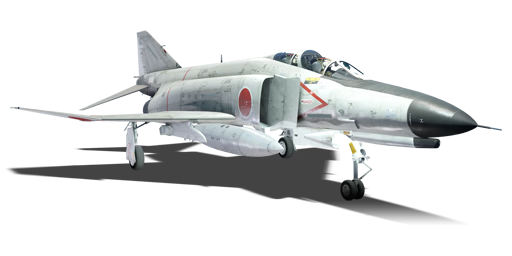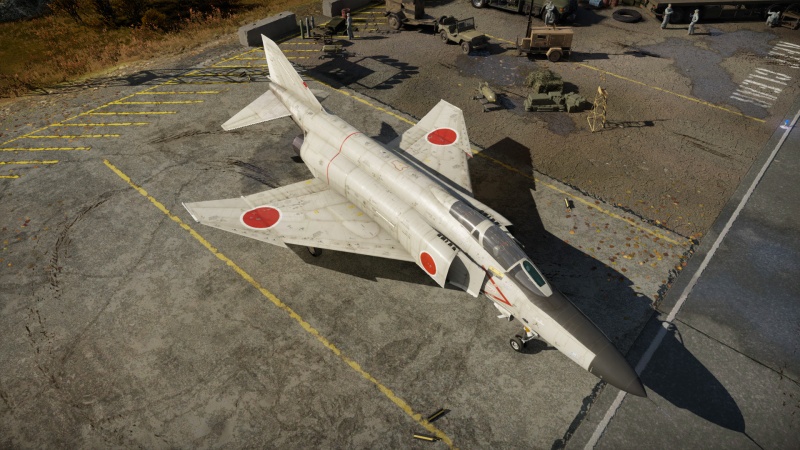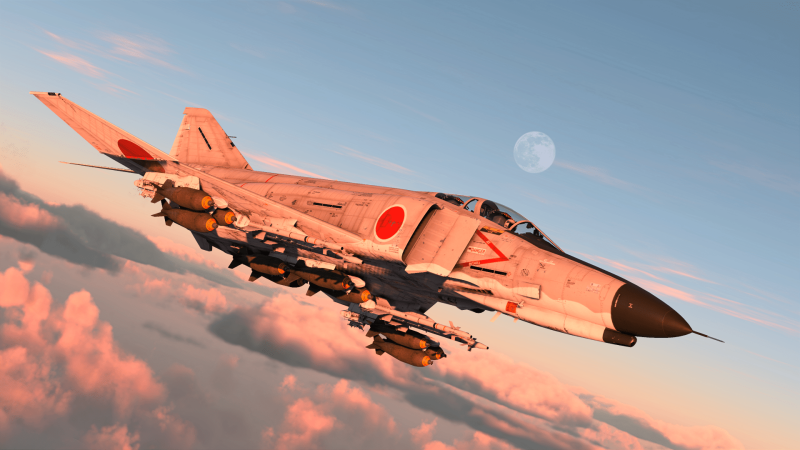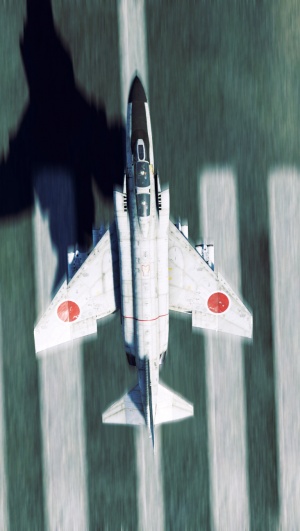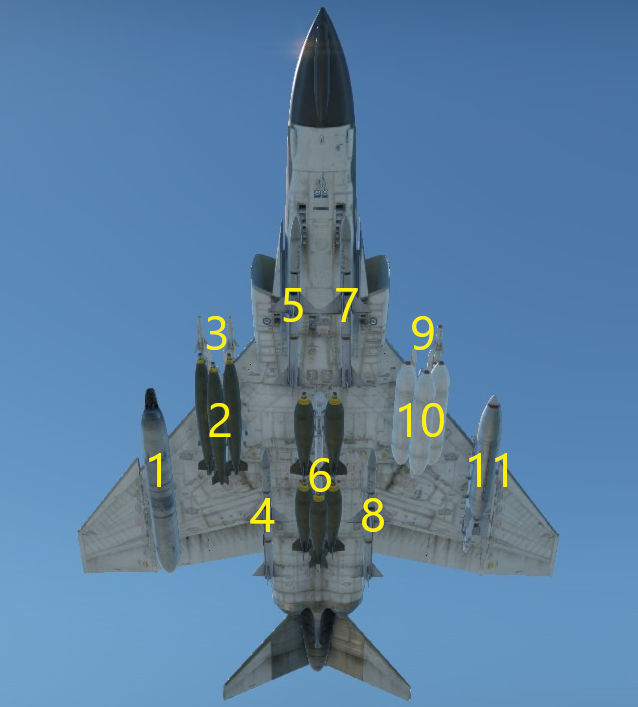Difference between revisions of "F-4EJ Phantom II"
Colok76286 (talk | contribs) (Edits) |
(→Armaments) |
||
| (12 intermediate revisions by 6 users not shown) | |||
| Line 11: | Line 11: | ||
== Description == | == Description == | ||
<!-- ''In the description, the first part should be about the history of and the creation and combat usage of the aircraft, as well as its key features. In the second part, tell the reader about the aircraft in the game. Insert a screenshot of the vehicle, so that if the novice player does not remember the vehicle by name, he will immediately understand what kind of vehicle the article is talking about.'' --> | <!-- ''In the description, the first part should be about the history of and the creation and combat usage of the aircraft, as well as its key features. In the second part, tell the reader about the aircraft in the game. Insert a screenshot of the vehicle, so that if the novice player does not remember the vehicle by name, he will immediately understand what kind of vehicle the article is talking about.'' --> | ||
| − | The ''' | + | The '''F-4EJ''' was a version of the [[F-4 Phantom II (Family)|Phantom II]], a versatile fighter jet designed by McDonnell Douglas in the late 1950s. Japan bought 140 F-4EJs in 1968, based on the [[F-4E]] model used by the U.S. Air Force, but with some changes such as the removal of aerial refueling and ground attack capabilities. Mitsubishi Heavy Industries also built 138 F-4EJs under license. The F-4EJ served as Japan's main air defense fighter for many years, until it was gradually replaced by the Mitsubishi F-2 and the F-35A Joint Strike Fighter. Japan also operated a reconnaissance version of the F-4EJ, the RF-4EJ, which had no weapons and carried cameras and sensors. The RF-4EJ retired in March 2020, followed by the last F-4EJ in December 2020, marking the end of an era for Japan's "Phantastic Phantoms". |
| + | |||
| + | It was introduced in [[Update 1.97 "Viking Fury"]]. The F-4EJ Phantom II is a versatile jet that can attack ground and air targets with bombs, rockets, missiles, and cannons. It can also mount three extra gun pods for more firepower, but this reduces its speed and agility. The plane has decent missiles and a frontal cannon that can take down enemy aircraft with ease. Due to its lack of Agile Eagle upgrades, F-4EJ is not as manoeuvrable as the [[F-4C|F-4E]], [[F-4F Early (Germany)|F-4F Early]], and [[F-4F (Germany)|F-4F]]. It should avoid turn fights with lighter jets, instead relying on its generous armament and speed to make hit and run attacks. | ||
== General info == | == General info == | ||
| Line 121: | Line 123: | ||
{| class="wikitable" style="text-align:center" | {| class="wikitable" style="text-align:center" | ||
|- | |- | ||
| − | ! colspan=" | + | ! colspan="5" | [[Ballistic Computer]] |
|- | |- | ||
| − | ! CCIP (Guns) !! CCIP (Rockets) !! CCIP (Bombs) !! CCRP (Bombs) | + | ! CCIP (Guns) !! CCIP (Rockets) !! CCIP (Bombs) !! CCRP (Bombs) !! EEGS |
|- | |- | ||
| − | | {{Tick}} || {{Tick}} || {{Tick}} || {{Tick}} | + | | {{Tick}} || {{Tick}} || {{Tick}} || {{Tick}} || {{Tick}} |
|- | |- | ||
|} | |} | ||
| Line 135: | Line 137: | ||
The '''''{{PAGENAME}}''''' is armed with: | The '''''{{PAGENAME}}''''' is armed with: | ||
| − | + | * 1 x 20 mm JM61A1 cannon, chin-mounted (640 rpg) | |
| − | + | * 30 x large calibre countermeasures | |
| − | ** | + | * 60 x countermeasures |
Due to this cannon's high rate of fire (only 6.60 seconds of continuous fire), trigger discipline is a must. | Due to this cannon's high rate of fire (only 6.60 seconds of continuous fire), trigger discipline is a must. | ||
| Line 144: | Line 146: | ||
{{Specs-Avia-Suspended}} | {{Specs-Avia-Suspended}} | ||
<!-- ''Describe the aircraft's suspended armament: additional cannons under the wings, bombs, rockets and torpedoes. This section is especially important for bombers and attackers. If there is no suspended weaponry remove this subsection.'' --> | <!-- ''Describe the aircraft's suspended armament: additional cannons under the wings, bombs, rockets and torpedoes. This section is especially important for bombers and attackers. If there is no suspended weaponry remove this subsection.'' --> | ||
| − | |||
| − | |||
| − | |||
| − | |||
| − | + | The '''''{{PAGENAME}}''''' can be outfitted with the following ordnance: | |
| − | |||
| − | |||
| − | |||
| − | |||
| − | |||
| − | |||
| − | |||
| − | |||
| − | |||
| − | |||
| − | + | {| class="wikitable" style="text-align:center" width="100%" | |
| − | {| class="wikitable | ||
|- | |- | ||
! !! width="4%" | 1 !! width="4%" | 2 !! width="4%" | 3 !! width="4%" | 4 !! width="4%" | 5 !! width="4%" | 6 !! width="4%" | 7 !! width="4%" | 8 !! width="4%" | 9 !! width="4%" | 10 !! width="4%" | 11 | ! !! width="4%" | 1 !! width="4%" | 2 !! width="4%" | 3 !! width="4%" | 4 !! width="4%" | 5 !! width="4%" | 6 !! width="4%" | 7 !! width="4%" | 8 !! width="4%" | 9 !! width="4%" | 10 !! width="4%" | 11 | ||
| − | | rowspan=" | + | | rowspan="13" width="30%" | <div class="ttx-image">[[File:Hardpoints_F-4C_Phantom_II.png]]</div> |
|- | |- | ||
| − | ! 20 mm GAU-4 cannons ( | + | ! [[GAU-4 (20 mm)|20 mm GAU-4]] cannons (1,200 rpg) |
| 1 || || || || || 1 || || || || || 1 | | 1 || || || || || 1 || || || || || 1 | ||
|- | |- | ||
| − | ! 500 lb LDGP Mk 82 bombs | + | ! [[LDGP Mk 82 (500 lb)|500 lb LDGP Mk 82]] bombs |
| 6 || 3 || || || || 6 || || || || 3 || 6 | | 6 || 3 || || || || 6 || || || || 3 || 6 | ||
|- | |- | ||
| − | ! 750 lb M117 cone 45 bombs | + | ! [[Mk 82 Snakeye (500 lb)|500 lb Mk 82 Snakeye]] bombs |
| + | | 6 || 3 || || || || 6 || || || || 3 || 6 | ||
| + | |- | ||
| + | ! [[M117 cone 45 (750 lb)|750 lb M117 cone 45]] bombs | ||
| 3 || 3 || || || || 5 || || || || 3 || 3 | | 3 || 3 || || || || 5 || || || || 3 || 3 | ||
|- | |- | ||
| − | ! FFAR Mighty Mouse rockets | + | ! [[FFAR Mighty Mouse]] rockets |
| 57 || 57 || || || || 57 || || || || 57 || 57 | | 57 || 57 || || || || 57 || || || || 57 || 57 | ||
|- | |- | ||
| − | ! Zuni Mk32 Mod 0 ATAP rockets | + | ! [[Zuni Mk32 Mod 0 ATAP]] rockets |
| 12 || 12 || || || || 12 || || || || 12 || 12 | | 12 || 12 || || || || 12 || || || || 12 || 12 | ||
|- | |- | ||
| − | ! AIM-7D Sparrow missiles | + | ! [[AIM-7D Sparrow]] missiles |
| || || || 1 || 1 || || 1 || 1 || || || | | || || || 1 || 1 || || 1 || 1 || || || | ||
|- | |- | ||
| − | ! AIM-7E Sparrow missiles | + | ! [[AIM-7E Sparrow]] missiles |
| || || || 1 || 1 || || 1 || 1 || || || | | || || || 1 || 1 || || 1 || 1 || || || | ||
|- | |- | ||
| − | ! AIM-9E Sidewinder missiles | + | ! [[AIM-9E Sidewinder]] missiles |
| || || 1, 2 || || || || || || 1, 2 || || | | || || 1, 2 || || || || || || 1, 2 || || | ||
|- | |- | ||
| − | ! AIM-9P Sidewinder missiles | + | ! [[AIM-9P Sidewinder]] missiles |
| || || 2 || || || || || || 2 || || | | || || 2 || || || || || || 2 || || | ||
|- | |- | ||
| − | | colspan="12" | Maximum permissible weight imbalance: 1,500 kg | + | ! 600 gal drop tanks |
| + | | || || || || || 1 || || || || || | ||
| + | |- | ||
| + | | colspan="12" | Maximum permissible loadout weight: 7,400 kg<br>Maximum permissible wing load: 3,000 kg<br>Maximum permissible weight imbalance: 1,500 kg | ||
|- | |- | ||
|} | |} | ||
| + | |||
| + | {{Navigation-Start|Default weapon presets}} | ||
| + | {{Navigation-First-Simple-Line}} | ||
| + | |||
| + | * 1 x 600 gal drop tank | ||
| + | * 2 x AIM-9E Sidewinder missiles | ||
| + | * 4 x AIM-9E Sidewinder missiles | ||
| + | * 4 x AIM-9P Sidewinder missiles | ||
| + | * 4 x AIM-7D Sparrow missiles | ||
| + | * 4 x AIM-7E Sparrow missiles | ||
| + | * 24 x 500 lb LDGP Mk 82 bombs (12,000 lb total) | ||
| + | * 24 x 500 lb Mk 82 Snakeye bombs (12,000 lb total) | ||
| + | * 17 x 750 lb M117 cone 45 bombs (12,750 lb total) | ||
| + | * 285 x FFAR Mighty Mouse rockets | ||
| + | * 60 x Zuni Mk32 Mod 0 ATAP rockets | ||
| + | * 3 x 20 mm GAU-4 cannons (1,200 rpg = 3,600 total) | ||
| + | {{Navigation-End}} | ||
== Usage in battles == | == Usage in battles == | ||
<!-- ''Describe the tactics of playing in the aircraft, the features of using aircraft in a team and advice on tactics. Refrain from creating a "guide" - do not impose a single point of view, but instead, give the reader food for thought. Examine the most dangerous enemies and give recommendations on fighting them. If necessary, note the specifics of the game in different modes (AB, RB, SB).'' --> | <!-- ''Describe the tactics of playing in the aircraft, the features of using aircraft in a team and advice on tactics. Refrain from creating a "guide" - do not impose a single point of view, but instead, give the reader food for thought. Examine the most dangerous enemies and give recommendations on fighting them. If necessary, note the specifics of the game in different modes (AB, RB, SB).'' --> | ||
| − | The F-4EJ Phantom is | + | The F-4EJ Phantom II is best described as a mixed bag. It is a potent fighter-bomber, capable of carrying x24 500lb bombs along with a full payload of Sparrows and Sidewinders. This means that, with some luck, the F-4EJ Phantom destroy two bases before circling around to engage the enemy in their unguarded flanks. However, this is not advisable and largely depends on luck, as you will likely be swamped by masses of low-flying aircraft who will have no issues completely outperforming you with a full bomb load. The ideal role for the F-4EJ is as a high-altitude Interceptor, being faster and more well-armed than many aircraft that will be up there with you. In a downtier, climbing at around 20-30° (depending on whether you want to be faster or more well-positioned) to a height of 5kms or higher generally means that your Sparrows, with better performance, will often be able to take out high-flying aircraft with impunity. It can hold its own against some opponents, but generally avoid a turnfight with the generally accepted threats such as F-5Cs and Drakens and most Mig-21s, who will have no issue dancing around your nose. While most aircraft can be beaten with careful application of airbrakes and the planes, almost any delta wing aircraft, namely the Mirage III, MiG-21 and J35D, being nigh impossible to beat. To have any chance of beating delta winged jets you must force the fight into the sustained regime where some delta winged jets flown by inexperienced pilots may struggle to rate with you. |
| − | + | The main armament of the F-4EJ are its x4 AIM-9P short-range IR missiles, x4 longer-ranged, faster AIM-7E SARH missiles, and the notorious M61 Vulcan 20mm rotary cannon. Players familiar with the earlier Rank 6 Japanese jets should have no trouble using this cannon, with devastating firepower and a tight-spread when upgraded, the Vulcan will be far more effective due to the increased maneuverability of the F-4EJ. The AIM-7E will often be the primary weapon when dealing with targets at altitude, having much better range and pull than the AIM-7D, you can easily get away with kills from a maximum of 15,000m away. The range of the missile's maximum effectiveness largely depends on the speed of the aircraft on launch, the direction of the target, the altitude of both the attacker and the defender, and the angle of launch. Be advised that the 7E tends not to do well launching at any maneuvering target under 5,000m away, due to the 1.5s it takes to reach full maneuverability. The AIM-9Ps are far more simple. Launch while fast, and they will pull hard into targets up to 1,000m away, often able to achieve locks at a 90° approach angle on targets with extremely hot engines such as other Phantoms, Tomcats and MiG-23s. | |
| − | + | When in an uptier, the playstyle changes very drastically. You will be fighting against Tornado ADVs, F-4S/J and FGR.2 Phantoms, Tomcats, Fulcrums, Floggers, Viggens, and many more aircraft that you have little to no chance against in a one-on-one engagement. Particularly oppressive are the F-14A and B, who vastly outrange you by a great margin, whilst also posessing far better flight performance due to their variable-wing sweep and much better engines. In a dogfight, the F-4EJ fares little better, as very little will struggle against you in a fight. Your best bet is to climb to medium altitude, staying behind your team while looking for high-flying targets for your Sparrows. Keep a very close eye on the plane's RWR and dive to the deck while notching and popping chaff if you get locked. You may also hug the deck, as radar missiles are unable to track when flying directly above tree-top level, though this will make your own Sparrows quite useless since you don't have a PD radar to ignore ground clutter. Playing as a Support Fighter is key to your survival in uptiers. | |
=== Pros and cons === | === Pros and cons === | ||
| Line 211: | Line 221: | ||
'''Pros:''' | '''Pros:''' | ||
| − | * | + | * Decent top speed |
| − | * AIM- | + | * AIM-9Ps can pull a respectable 20Gs, with a mild degree of flare resistance. |
| − | * Equipped with | + | * AIM-9Ps have radar-slaving capability. |
| − | * | + | * Equipped with x90 Countermeasures in varying orders. |
| − | * | + | * Can hold a wide and heavy range of payload options, including a full load of missiles and x24 500lb bombs. |
| − | * Makes use of a ballistic computer for assisting in the aim of cannons, rockets, and bombs against ground targets | + | * The M61 Vulcan is an incredibly dangerous weapon, with great all-round characteristics. |
| + | * The AIM-7E Sparrow is a decent mid-range weapon in downtiers, with competitive flight performance and range. | ||
| + | * Makes use of a ballistic computer for assisting in the aim of cannons, rockets, and bombs against ground targets. | ||
'''Cons:''' | '''Cons:''' | ||
| − | * | + | * Lack of Agile Eagle unlike F-4E and F-4F, giving it a wider turning arc, making it less likely to outturn its peers in the first turn. |
| − | * | + | * No combat flaps. Takeoff flaps have a low speed limit and high drag, which makes them not very useful in dogfights |
| − | * Quite large and heavy compared to other fighters at its rank | + | * The AIM-7E, compared to the 7E-2, takes 1.5s to begin maneuvering, making it worse at short-range shots. |
| + | * Trigger discipline is required to make the most of the plane's 640 rounds of 20mm ammo. | ||
| + | * Quite large and heavy compared to other fighters at its rank. | ||
| + | * Radar susceptible to ground clutter, making shots on lower-flying targets more difficult. | ||
== History == | == History == | ||
| Line 248: | Line 263: | ||
;Videos | ;Videos | ||
| − | {{Youtube-gallery|TWT-ETcU_No|'''The Shooting Range #198''' - ''Metal Beasts'' section at 05:01 discusses the {{PAGENAME}}.|PNkoJ-MFERc|'''Best naval fighters''' discusses the {{PAGENAME}} at 3:39 - ''War Thunder Official Channel''|DCvuy_E5ZAk|'''JASDF F-4EJ Phantom II: Actual Sound Recording''' - ''DMM GAMES Official Channel''}} | + | {{Youtube-gallery|TWT-ETcU_No|'''The Shooting Range #198''' - ''Metal Beasts'' section at 05:01 discusses the {{PAGENAME}}.|PNkoJ-MFERc|'''Best naval fighters''' discusses the {{PAGENAME}} at 3:39 - ''War Thunder Official Channel''|DCvuy_E5ZAk|'''JASDF F-4EJ Phantom II: Actual Sound Recording''' - ''DMM GAMES Official Channel''|wzoNirlvARE|'''F-4 PHANTOM Ⅱ JASDF Final year''' - ''Yomiuri Shimbun''}} |
== See also == | == See also == | ||
Latest revision as of 07:51, 23 August 2024
| This page is about the Japanese jet fighter F-4EJ Phantom II. For other versions, see F-4 Phantom II (Family). |
Contents
Description
The F-4EJ was a version of the Phantom II, a versatile fighter jet designed by McDonnell Douglas in the late 1950s. Japan bought 140 F-4EJs in 1968, based on the F-4E model used by the U.S. Air Force, but with some changes such as the removal of aerial refueling and ground attack capabilities. Mitsubishi Heavy Industries also built 138 F-4EJs under license. The F-4EJ served as Japan's main air defense fighter for many years, until it was gradually replaced by the Mitsubishi F-2 and the F-35A Joint Strike Fighter. Japan also operated a reconnaissance version of the F-4EJ, the RF-4EJ, which had no weapons and carried cameras and sensors. The RF-4EJ retired in March 2020, followed by the last F-4EJ in December 2020, marking the end of an era for Japan's "Phantastic Phantoms".
It was introduced in Update 1.97 "Viking Fury". The F-4EJ Phantom II is a versatile jet that can attack ground and air targets with bombs, rockets, missiles, and cannons. It can also mount three extra gun pods for more firepower, but this reduces its speed and agility. The plane has decent missiles and a frontal cannon that can take down enemy aircraft with ease. Due to its lack of Agile Eagle upgrades, F-4EJ is not as manoeuvrable as the F-4E, F-4F Early, and F-4F. It should avoid turn fights with lighter jets, instead relying on its generous armament and speed to make hit and run attacks.
General info
Flight performance
| Characteristics | Max Speed (km/h at 12,192 m) |
Max altitude (metres) |
Turn time (seconds) |
Rate of climb (metres/second) |
Take-off run (metres) | |||
|---|---|---|---|---|---|---|---|---|
| AB | RB | AB | RB | AB | RB | |||
| Stock | 2,255 | 2,221 | 16000 | 26.5 | 27.4 | 141.6 | 131.6 | 850 |
| Upgraded | 2,419 | 2,340 | 25.6 | 26.0 | 204.3 | 172.0 | ||
Details
| Features | |||||
|---|---|---|---|---|---|
| Combat flaps | Take-off flaps | Landing flaps | Air brakes | Arrestor gear | Drogue chute |
| X | ✓ | ✓ | ✓ | ✓ | ✓ |
| Limits | ||||||
|---|---|---|---|---|---|---|
| Wings (km/h) | Gear (km/h) | Flaps (km/h) | Max Static G | |||
| Combat | Take-off | Landing | + | - | ||
| 1458 | 463 | N/A | 580 | 463 | ~11 | ~4 |
| Optimal velocities (km/h) | |||
|---|---|---|---|
| Ailerons | Rudder | Elevators | Radiator |
| < 810 | < 750 | < 700 | N/A |
Engine performance
| Engine | Aircraft mass | |||||
|---|---|---|---|---|---|---|
| Engine name | Number | Basic mass | Wing loading (full fuel) | |||
| General Electric J79-GE-17 | 2 | 13,965 kg | 403 kg/m2 | |||
| Engine characteristics | Mass with fuel (no weapons load) | Max Takeoff Weight | ||||
| Weight (each) | Type | 9m fuel | 20m fuel | 30m fuel | ||
| 1,750 kg | Afterburning axial-flow turbojet | 15,724 kg | 17,787 kg | 19,829 kg | 24,000 kg | |
| Maximum engine thrust @ 0 m (RB/SB) | Thrust to weight ratio @ 0 m (WEP) | |||||
| Condition | 100% | WEP | 9m fuel | 20m fuel | 30m fuel | MTOW |
| Stationary | 5,200 kgf | 8,008 kgf | 1.02 | 0.90 | 0.81 | 0.67 |
| Optimal | 5,200 kgf (0 km/h) |
10,170 kgf (1,400 km/h) |
1.29 | 1.14 | 1.03 | 0.85 |
Survivability and armour
- 8.5 mm of Steel below the cockpit.
Modifications and economy
Armaments
| Ballistic Computer | ||||
|---|---|---|---|---|
| CCIP (Guns) | CCIP (Rockets) | CCIP (Bombs) | CCRP (Bombs) | EEGS |
| |
|
|
|
|
Offensive armament
The F-4EJ Phantom II is armed with:
- 1 x 20 mm JM61A1 cannon, chin-mounted (640 rpg)
- 30 x large calibre countermeasures
- 60 x countermeasures
Due to this cannon's high rate of fire (only 6.60 seconds of continuous fire), trigger discipline is a must.
Suspended armament
The F-4EJ Phantom II can be outfitted with the following ordnance:
| 1 | 2 | 3 | 4 | 5 | 6 | 7 | 8 | 9 | 10 | 11 | ||
|---|---|---|---|---|---|---|---|---|---|---|---|---|
| 20 mm GAU-4 cannons (1,200 rpg) | 1 | 1 | 1 | |||||||||
| 500 lb LDGP Mk 82 bombs | 6 | 3 | 6 | 3 | 6 | |||||||
| 500 lb Mk 82 Snakeye bombs | 6 | 3 | 6 | 3 | 6 | |||||||
| 750 lb M117 cone 45 bombs | 3 | 3 | 5 | 3 | 3 | |||||||
| FFAR Mighty Mouse rockets | 57 | 57 | 57 | 57 | 57 | |||||||
| Zuni Mk32 Mod 0 ATAP rockets | 12 | 12 | 12 | 12 | 12 | |||||||
| AIM-7D Sparrow missiles | 1 | 1 | 1 | 1 | ||||||||
| AIM-7E Sparrow missiles | 1 | 1 | 1 | 1 | ||||||||
| AIM-9E Sidewinder missiles | 1, 2 | 1, 2 | ||||||||||
| AIM-9P Sidewinder missiles | 2 | 2 | ||||||||||
| 600 gal drop tanks | 1 | |||||||||||
| Maximum permissible loadout weight: 7,400 kg Maximum permissible wing load: 3,000 kg Maximum permissible weight imbalance: 1,500 kg | ||||||||||||
| Default weapon presets | |
|---|---|
| |
Usage in battles
The F-4EJ Phantom II is best described as a mixed bag. It is a potent fighter-bomber, capable of carrying x24 500lb bombs along with a full payload of Sparrows and Sidewinders. This means that, with some luck, the F-4EJ Phantom destroy two bases before circling around to engage the enemy in their unguarded flanks. However, this is not advisable and largely depends on luck, as you will likely be swamped by masses of low-flying aircraft who will have no issues completely outperforming you with a full bomb load. The ideal role for the F-4EJ is as a high-altitude Interceptor, being faster and more well-armed than many aircraft that will be up there with you. In a downtier, climbing at around 20-30° (depending on whether you want to be faster or more well-positioned) to a height of 5kms or higher generally means that your Sparrows, with better performance, will often be able to take out high-flying aircraft with impunity. It can hold its own against some opponents, but generally avoid a turnfight with the generally accepted threats such as F-5Cs and Drakens and most Mig-21s, who will have no issue dancing around your nose. While most aircraft can be beaten with careful application of airbrakes and the planes, almost any delta wing aircraft, namely the Mirage III, MiG-21 and J35D, being nigh impossible to beat. To have any chance of beating delta winged jets you must force the fight into the sustained regime where some delta winged jets flown by inexperienced pilots may struggle to rate with you.
The main armament of the F-4EJ are its x4 AIM-9P short-range IR missiles, x4 longer-ranged, faster AIM-7E SARH missiles, and the notorious M61 Vulcan 20mm rotary cannon. Players familiar with the earlier Rank 6 Japanese jets should have no trouble using this cannon, with devastating firepower and a tight-spread when upgraded, the Vulcan will be far more effective due to the increased maneuverability of the F-4EJ. The AIM-7E will often be the primary weapon when dealing with targets at altitude, having much better range and pull than the AIM-7D, you can easily get away with kills from a maximum of 15,000m away. The range of the missile's maximum effectiveness largely depends on the speed of the aircraft on launch, the direction of the target, the altitude of both the attacker and the defender, and the angle of launch. Be advised that the 7E tends not to do well launching at any maneuvering target under 5,000m away, due to the 1.5s it takes to reach full maneuverability. The AIM-9Ps are far more simple. Launch while fast, and they will pull hard into targets up to 1,000m away, often able to achieve locks at a 90° approach angle on targets with extremely hot engines such as other Phantoms, Tomcats and MiG-23s.
When in an uptier, the playstyle changes very drastically. You will be fighting against Tornado ADVs, F-4S/J and FGR.2 Phantoms, Tomcats, Fulcrums, Floggers, Viggens, and many more aircraft that you have little to no chance against in a one-on-one engagement. Particularly oppressive are the F-14A and B, who vastly outrange you by a great margin, whilst also posessing far better flight performance due to their variable-wing sweep and much better engines. In a dogfight, the F-4EJ fares little better, as very little will struggle against you in a fight. Your best bet is to climb to medium altitude, staying behind your team while looking for high-flying targets for your Sparrows. Keep a very close eye on the plane's RWR and dive to the deck while notching and popping chaff if you get locked. You may also hug the deck, as radar missiles are unable to track when flying directly above tree-top level, though this will make your own Sparrows quite useless since you don't have a PD radar to ignore ground clutter. Playing as a Support Fighter is key to your survival in uptiers.
Pros and cons
Pros:
- Decent top speed
- AIM-9Ps can pull a respectable 20Gs, with a mild degree of flare resistance.
- AIM-9Ps have radar-slaving capability.
- Equipped with x90 Countermeasures in varying orders.
- Can hold a wide and heavy range of payload options, including a full load of missiles and x24 500lb bombs.
- The M61 Vulcan is an incredibly dangerous weapon, with great all-round characteristics.
- The AIM-7E Sparrow is a decent mid-range weapon in downtiers, with competitive flight performance and range.
- Makes use of a ballistic computer for assisting in the aim of cannons, rockets, and bombs against ground targets.
Cons:
- Lack of Agile Eagle unlike F-4E and F-4F, giving it a wider turning arc, making it less likely to outturn its peers in the first turn.
- No combat flaps. Takeoff flaps have a low speed limit and high drag, which makes them not very useful in dogfights
- The AIM-7E, compared to the 7E-2, takes 1.5s to begin maneuvering, making it worse at short-range shots.
- Trigger discipline is required to make the most of the plane's 640 rounds of 20mm ammo.
- Quite large and heavy compared to other fighters at its rank.
- Radar susceptible to ground clutter, making shots on lower-flying targets more difficult.
History
F-4EJ "Samurai Phantom" was a jet fighter aircraft that saw service in the JASDF (Japanese Air Self Defense Force) from 1971 until 2020. At the end of 2020, the F-4EJ will be replaced by the F-35A Lightning II.
In 1968 Japan made it public that they would update their JASDF with the F-4 phantom. Being one of the only countries to acquire the permissions to build the plane in their own Factories, Japan started to develop the F-4EJ at Mitsubishi Heavy Industries. Due to post WW2 sanctions and restrictions, Japan was not allowed to equip any air-to-surface capabilities to the aircraft. As such, the F-4EJ would be made without the AN/AJB-7 bombing computer system.
McDonnell Douglas built the first 2, F-4EJ prototypes with Mitsubishi Heavy Industries building the remaining Phantoms. They did, however, import RF-4EJ from McDonnell Douglas over the 10-year span of production. Mitsubishi Heavy Industries would build the very last F-4 in the world, nicknamed "The Finale Phantom", on the 20th of May, 1981. It served with the 306th and 301st Tactical Fighter Squadrons. 127 EJ variant Phantoms were built.
The first squadron equipped with the new F-4EJ would be the 301st Hikotai, in August 1st 1972. In October 1973, the 301st would be deemed operational with the Phantom, having 14 Phantoms in their squadron. On October 30th 1978, five years after the squadron was equipped and trained in the Phantom: the 301st was designated as JASDF Quick Ready Alert force. In 1979 they would be the first F-4EJ to intercept another aircraft when a Soviet Tu-95 was deemed a threat on February 21st of that year. Ironically the same day of the intercept is when Japan launched the Hakucho X-ray satellite & Corsa-B.
In July of 1984, after the post-war sanctions were dropped, Japan put together plans to upgrade its F-4EJ Phantoms. In 1989 their F-4EJ Phantoms were updated starting with the 306th Hikotai. The new Phantoms were equipped with APG-66J pulse-Doppler radar, which allowed the Phantoms to carry out air-to-ground and Air-to-Ship capabilities while being lighter, smaller, and more efficient than the old radar. A new computer and heads up display was added to Phantom, allowing them to bring the Phantom into the 21st century. Additional upgrades to the pylons allowed the new Phantoms to be equipped with the F-15 fuel tanks, which could sustain more G forces than the current fuel tanks being used. And with the adoption of the Westinghouse AN/ALQ-131 countermeasures, it allowed the pilot to adapt and counter any threats on the modern battlefield quickly. These upgrades were desperately needed for the JASDF as their Mitsubishi F-1 and F-2 did not have the range needed to adequately defend their countries territory if war ever arose. 96 Phantoms were upgraded and designated as F-4EJ Kai (Kai means "Modified" in Japanese).
The F-4EJ Phantoms were equipped with 3 different colour schemes. Blue Camo, Green Camo, and Grey. 127 aircraft were built, with 8 squadrons adopting the plane. The F-4EJ was decommissioned in 2020 to adapt to the F-35A Lightning II.
Media
- Skins
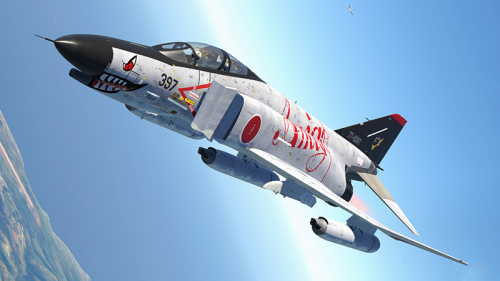
- Videos
See also
- Related development
- Aircraft of comparable role, configuration and era
- Mikoyan-Gurevich MiG-21 (Family)
- SAAB J35D Draken
- Dassault Mirage IIIC
External links
| Japan jet aircraft | |
|---|---|
| IJNAS | |
| Experimental | Kikka |
| Reconnaissance | R2Y2 Kai V1 · R2Y2 Kai V2 · R2Y2 Kai V3 |
| IJAAS | |
| Fighters | Ki-200 |
| JASDF | |
| Fighters | F-86F-30 ▅ · F-86F-40 ▅ · F-86F-40 JASDF▅ |
| F-104J | |
| F-4EJ Phantom II · F-4EJ ADTW · F-4EJ Kai Phantom II | |
| F-15J · F-15J(M) | |
| F-16AJ | |
| F-1 | |
| Trainers | T-2 Early · T-2 |
| Foreign | |
| Thailand | ▄AV-8S · ▄F-5E FCU |


